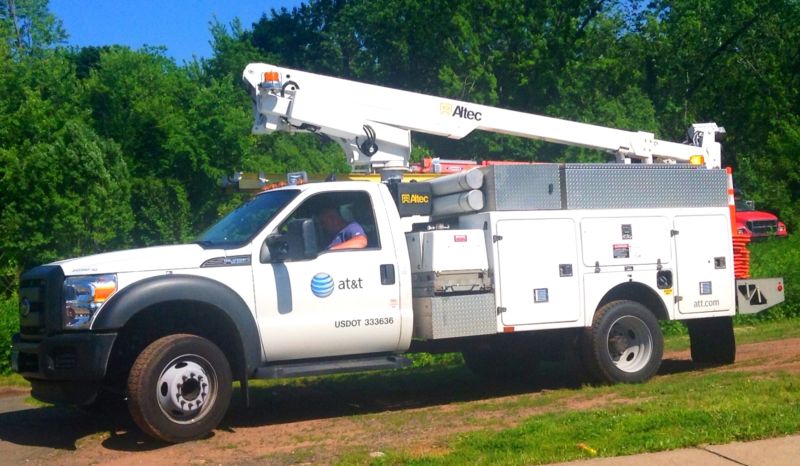Cutting costs –
AT&T mostly stopped fiber-to-the-home deployment despite tax cut and deregulation.
Jon Brodkin –)

Enlarge/An AT&T repair truck.
AT&T is planning to spend just $ (billion on capital investment in 2020, down from $ 23 billion this year.
AT&T announced the $ 20 billion forecast for 2020 Monday in itsQuarterly earnings. A year ago,AT&T saidit would spend $ 23 Billion on gross capital investment in 2019. (These numbers include network construction and vendor-financing payments but do not include some spending on AT & T’s FirstNet public safety network, which is reimbursed by the federal government.)
The company is on pace to exceed its (goal as it averagedmore than $ 6 billion per quarterin the first three quarters. But with a forecast of $ 20 billion across all of 2020, AT&T expects to spend about $ 5 billion per quarter on capital investments going forward. The company is under pressure from investors to control spending, in part because its TV business istankingand because of AT & T’s giant debt load stemming from the purchases of DirecTV and Time Warner.
AT&T increased capital investment between 2018 and 2019, but its 2020 outlook would push the company’s spending to lower than its 2018 total of $ 21 .8 billion. AT&T,as you might remember, promised increased capital spending and thousands of new jobs in exchange for a corporate tax cut andclaimedthat the now-repealed federal net neutrality rules harmed broadband-network investment. The tax cut alonereportedlygave AT&T an extra $ 3 billion in cash in 2018, and it continues to give the companylower tax rateseach year. Despite that, AT&Tsaidit has cut its workforce from 269, 280 employees to 251, 840 employees in the past year.
AT & T’s capital spending will decline next year despite the company’s plan to roll 5G mobile service out nationwide. AT&T already got much of the 5G spending out of the way by purchasing spectrum licenses, and AT&T CEO Randall Stephensontold investorsthat the company’s “strong spectrum position will allow for lower capital intensity” over the next three years.
AT&T has alsomostly stoppedits fiber-to-the-home broadband construction even though large portions of its 21 – state territory still have only copper-based DSL service. Fiber deployment isn’t stopping completely, as Stephenson said that “5G requires us to continue deploying fiber.” But AT&T customers who can’t get modern broadband speeds or reliable wireline service in their homes would welcome more capital investment in their neighborhoods.
AT & T’s capital investment has an outsized influence on the industry numbers as a whole. As Stephenson said, the $ 20 billion AT&T plans in 2020 is “the most aggressive investment in the industry” even though it’s low by AT & T’s recent standards.
Tax cut, deregulation didn’t boost investment
AT&T slashing $ 3 billion off its capital investment will hurt Federal Communications Commission Chairman Ajit Pai’s attempts to claim that his deregulatory initiatives have raised broadband investment. Pai has repeatedlycited capital-expenditure numbersin hisargumentthat net neutrality rules caused broadband providers to reduce investment.
Pai has alsotaken creditfor AT & T’s fiber-to-the-home deployment, even though AT&T completed that multi-year project as part of adeal with Pai’s predecessor, Tom Wheeler. AT & T’s decisions to lower capital investment and stop expanding fiber-to-the-home broadband may force Pai to look elsewhere for data to support his deregulatory preferences.
AT & T’s lower-than-expected spending forecast for 2020 “surprised Wall Street analysts,”Light Reading reported today. “The reduction was such that the analysts at Wall Street research firm Cowen lowered their capex forecasts for AT&T to roughly $ (billion in) and 2022, a decrease from their previous forecast of around $ 21 billion, “the article said.
Comcast, Charter cut cable spending
Capital expenditures for other carriers are also lower than expected. “Comcast and Charter missed 3Q expectations for capex and guided 2019 lower than previously planned, “analysts at Nomura’s Instinet wrote in a note to investors, according to Light Reading. “We have lowered our combined 2019 capex forecast for Comcast and Charter from $ .6 billion to $ 2 billion. “
Comcast saidits cable division’s capital expenditures “decreased 6.7% to $ 1.8 billion” in the quarter. “For the nine months ending September 30, Comcast cable’s “capital expenditures decreased 11. 7% to $ 4.8 billion, “the company said. (Comcast’s overall capital expenditures increased because of a rise in NBCUniversal spending.)
Charter saidthat its third-quarter “capital expenditures totaled $ 1.7 billion compared to $ 2.1 billion during the third quarter of 2018. “
“Charter currently expects capital expenditures, excluding capital expenditures related to mobile, to be slightly below $ 7 billion in 2019, versus $ 8.9 billion in 2018, “the company said.
Verizon spent $ 4.4 billion in capital expenditures in the third quarter, “roughly $ 100 million below most Wall Street expectations, “but Verizon still expects to hit its full-year forecast of $ 17 billion to $ 18 billion in 2019, Light Reading wrote.
Disclosure: The Advance / Newhouse Partnership, which owns 13% of Charter, is part of Advance Publications. Advance Publications owns Condé Nast, which owns Ars Technica.






GIPHY App Key not set. Please check settings